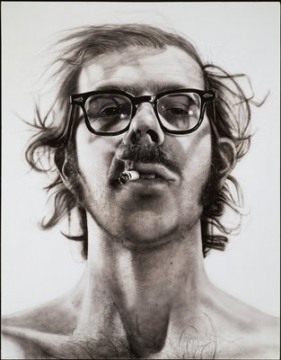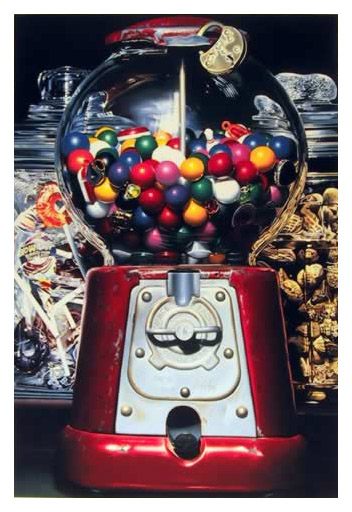During the Summer I have been researching into the art movement of Photorealism. Developed in the United States of America in the late 1960s, early 1970s, photorealism is a genre of paintings based on a photograph. The paintings cannot exist without the photograph. Change and movement must be frozen in time which is then accurately represented by the artist. Once the image is developed, the image is transferred onto canvas either by projecting the image
or using the grid technique. The first generation of American photorealists includes painters such as Richard Estes, Ralph Goings, Chuck Close, Charles Bell, Audrey Flack and Don Eddy.
I love the Photorealist movement because the paintings look so similar to photographs due to theintricate delicate painting from the artists. At first glance, the viewer believes it to be a photograph, however at a closer inspection it is a painting. Although the movement is primarily associated with painting, Duane Hanson and John DeAndrea are sculptors associated with photorealism for their painted, life-like sculptors of average people that were complete with simulated hair and real clothes.

Tourists II, 1988
Fiberglass and mixed media, with accesories life size
Chuck Close "I am going for a level of perfection that is only mine... most of the pleasure is in getting the last little
piece perfect."
Chuck Close paints portraits of himself, family and friends, produced at a very large scale. Beginning with a photograph of a face, he uses the grid technique to copy the photograph onto canvas. Putting a grid on top of the photograph and the canvas, he copies it cell by cell. However, in 1988 Close had a spinal artery collapse, relying on a wheelchair ever since. Remarkably, he still manages to paint, using a paintbrush strapped to his wrist. He creates large port
raits in low resolution grid squares created by an assistant. The image is made up of minute multicoloured dots so that the viewers attention fluctuates between the surface pattern and overall picture.

Self-portrait, 1997
Oil on canvas 102 x 84 inchs

Big Self-Portrait, 1967-68
Acrylic on canvas 273 x 212 cm
Audrey Flack

Audrey Flack
Marilyn, 1977

Audrey Flack
Chanel, 1974
Richard Estes
My favourite photorealist artist, his paintings consist of reflective, clean inanimate city and geometric landscapes. Regarded as one of the founders of the moevement. In 1967, Estes began to paint shop fronts and buildings with glass windows, more importantly the reflected image shown on these windows. The paintings are based on colour photographs he would take, which traps the evanescent nature of the reflections, changing throughout the day due to the time of the day or weather conditions.

Richard Estes
Telephone Booths, 1968
Oil on Canvas

Richard Estes
Bus Reflections, 1974
Oil on Canvas
Don Eddy - New Shoes for 'H'

Don Eddy
New Shoes for 'H', 1973-74
Acrylic on Canvas
44 x 48 in.
Charles Bell
An american photorealist. The subject matter is depicted in a scale as much as ten times its life size. The colours are very clear and very vibrant, being achieved using oil paint. His work is noted not only for the glass-like surface but also for the significance in scale.

Charles Bell
Gumballs and Peanuts
16 x 20 in.
No comments:
Post a Comment